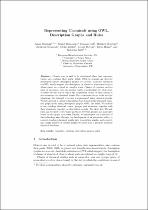JavaScript is disabled for your browser. Some features of this site may not work without it.
- ResearchSpace
- →
- Research Publications/Outputs
- →
- Conference Publications
- →
- View Item
| dc.contributor.author |
Hastings, J

|
|
| dc.contributor.author |
Dumontier, M

|
|
| dc.contributor.author |
Hull, D

|
|
| dc.contributor.author |
Horridge, M

|
|
| dc.contributor.author |
Steinbeck, C

|
|
| dc.contributor.author |
Sattler, U

|
|
| dc.contributor.author |
Stevens, R

|
|
| dc.contributor.author |
Horne, T

|
|
| dc.contributor.author |
Britz, K

|
|
| dc.date.accessioned | 2011-03-28T07:59:10Z | |
| dc.date.available | 2011-03-28T07:59:10Z | |
| dc.date.issued | 2010-06 | |
| dc.identifier.citation | Hastings, J, Dumontier, M, Hull D et al. 2010. Representing chemicals using OWL, description graphs and rules. OWL: experiences and directions, OWLED 2010: 7th International Workshop, San Francisco, California, USA, 21-22 June 2010, pp 10 | en_US |
| dc.identifier.issn | 1613-0073 | |
| dc.identifier.uri | http://krr.meraka.org.za/wp-content/uploads/2010/07/owled_descgraphschem_2010.pdf | |
| dc.identifier.uri | http://hdl.handle.net/10204/4919 | |
| dc.description | 7th International Workshop, San Francisco, California, USA, 21-22 June 2010 | en_US |
| dc.description.abstract | Objects can be said to be structured when their representation also contains their parts. While OWL in general can describe structured objects, description graphs are a recent, decidable extension to OWL which support the description of classes of structured objects whose parts are related in complex ways. Classes of chemical entities such as molecules, ions and groups (parts of molecules) are often characterised by the way in which the constituent atoms of their instances are connected via chemical bonds. For chemoinformatics tools and applications, this internal structure is represented using chemical graphs. We here present a chemical knowledge base based on the standard chemical graph model using description graphs, OWL and rules. We include in our ontology chemical classes, groups, and molecules, together with their structures encoded as description graphs. We show how DL-safe rules can be used to determine parthood between groups and molecules based on the graph structures. Finally, we investigate the scalability of the technology used through the development of an automatic utility to convert standard chemical graphs into description graphs, and converting a large number of diverse graphs obtained from a publicly available chemical database. | en_US |
| dc.language.iso | en | en_US |
| dc.relation.ispartofseries | Workflow;6073 | |
| dc.subject | Chemicals | en_US |
| dc.subject | Ontology | en_US |
| dc.subject | Description graphs | en_US |
| dc.subject | OWL | en_US |
| dc.subject | Molecule parts | en_US |
| dc.subject | Graph structures | en_US |
| dc.subject | Structured objects | en_US |
| dc.title | Representing chemicals using OWL, description graphs and rules | en_US |
| dc.type | Conference Presentation | en_US |
| dc.identifier.apacitation | Hastings, J., Dumontier, M., Hull, D., Horridge, M., Steinbeck, C., Sattler, U., ... Britz, K. (2010). Representing chemicals using OWL, description graphs and rules. http://hdl.handle.net/10204/4919 | en_ZA |
| dc.identifier.chicagocitation | Hastings, J, M Dumontier, D Hull, M Horridge, C Steinbeck, U Sattler, R Stevens, T Horne, and K Britz. "Representing chemicals using OWL, description graphs and rules." (2010): http://hdl.handle.net/10204/4919 | en_ZA |
| dc.identifier.vancouvercitation | Hastings J, Dumontier M, Hull D, Horridge M, Steinbeck C, Sattler U, et al, Representing chemicals using OWL, description graphs and rules; 2010. http://hdl.handle.net/10204/4919 . | en_ZA |
| dc.identifier.ris | TY - Conference Presentation AU - Hastings, J AU - Dumontier, M AU - Hull, D AU - Horridge, M AU - Steinbeck, C AU - Sattler, U AU - Stevens, R AU - Horne, T AU - Britz, K AB - Objects can be said to be structured when their representation also contains their parts. While OWL in general can describe structured objects, description graphs are a recent, decidable extension to OWL which support the description of classes of structured objects whose parts are related in complex ways. Classes of chemical entities such as molecules, ions and groups (parts of molecules) are often characterised by the way in which the constituent atoms of their instances are connected via chemical bonds. For chemoinformatics tools and applications, this internal structure is represented using chemical graphs. We here present a chemical knowledge base based on the standard chemical graph model using description graphs, OWL and rules. We include in our ontology chemical classes, groups, and molecules, together with their structures encoded as description graphs. We show how DL-safe rules can be used to determine parthood between groups and molecules based on the graph structures. Finally, we investigate the scalability of the technology used through the development of an automatic utility to convert standard chemical graphs into description graphs, and converting a large number of diverse graphs obtained from a publicly available chemical database. DA - 2010-06 DB - ResearchSpace DP - CSIR KW - Chemicals KW - Ontology KW - Description graphs KW - OWL KW - Molecule parts KW - Graph structures KW - Structured objects LK - https://researchspace.csir.co.za PY - 2010 SM - 1613-0073 T1 - Representing chemicals using OWL, description graphs and rules TI - Representing chemicals using OWL, description graphs and rules UR - http://hdl.handle.net/10204/4919 ER - | en_ZA |






